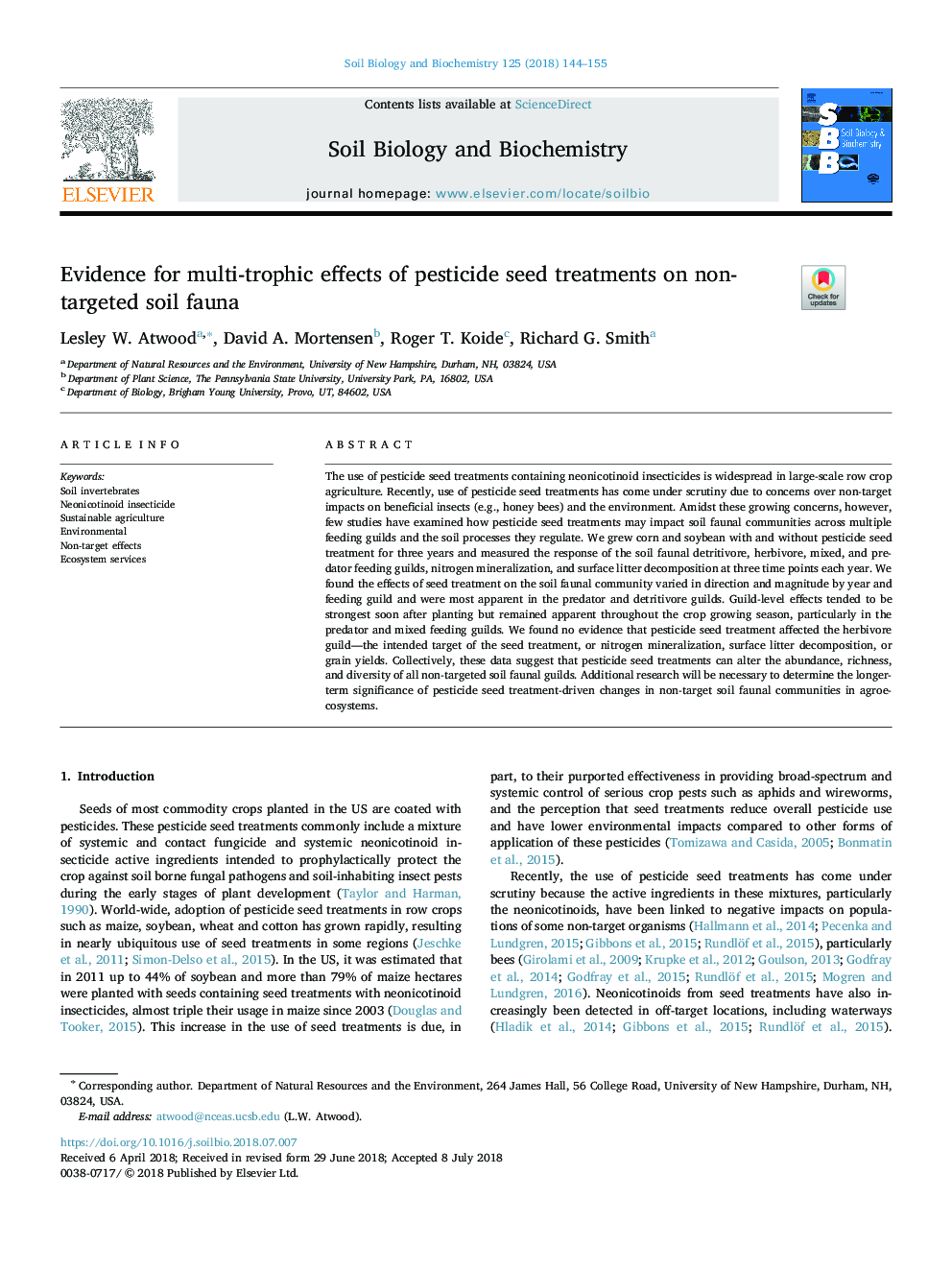| کد مقاله | کد نشریه | سال انتشار | مقاله انگلیسی | نسخه تمام متن |
|---|---|---|---|---|
| 8362451 | 1542559 | 2018 | 12 صفحه PDF | دانلود رایگان |
عنوان انگلیسی مقاله ISI
Evidence for multi-trophic effects of pesticide seed treatments on non-targeted soil fauna
ترجمه فارسی عنوان
شواهد اثرات چندتایی گیاهان زراعی بر روی آفات غیر هدفمند
دانلود مقاله + سفارش ترجمه
دانلود مقاله ISI انگلیسی
رایگان برای ایرانیان
کلمات کلیدی
زمین بی مهرگان، حشره کش نئونیکوتیوئید، کشاورزی پایدار، محیطی، اثرات غیر هدف، خدمات محیط زیستی،
ترجمه چکیده
استفاده از تیمارهای بذر سموم حاوی حشره کش های نئونیکوتینوئید در صنایع مختلف ریشه ای گسترده گسترش یافته است. به تازگی استفاده از درمان های بذر سموم با توجه به نگرانی ها در مورد اثرات غیر هدف بر حشرات مفید (مانند زنبور عسل) و محیط زیست مورد بررسی قرار گرفته است. در میان این نگرانی های در حال رشد، با این حال، تعداد کمی از مطالعات بررسی شده است که چگونه روش های تثبیت دانه های آفت کش ممکن است در جوامع فونیکی خشکسالی در بین صنایع مختلف تغذیه و فرآیندهای خاک آنها تنظیم شود. ما طی 3 سال با ذرت و سویا، بدون و بدون درمان با سموم دفع آفات رشد کردیم و پاسخ دهندگان گیاهخوار گیاهان دارویی، گیاهان دارویی، مخلوط و شکارچیان، کانه زایی نیتروژن و تجزیه بستر سطحی را در هر سه سال یکبار اندازه گیری کردیم. ما اثرات درمان بذر در جامعه فون خاک را بر اساس جهت و مقدار سالیانه و تغذیه درختان تغییر دادیم و بیشتر در صنایع شکارچی و شکست خورده مشاهده شد. اثرات سطوح صنوبر به زودی پس از کاشت قوی تر شد، اما در طول فصل رشد محصول، به ویژه در حیوانات شکارچی و غذای مخلوط، آشکار شد. ما هیچ مدرکی نداشتیم که درمان بذر سموم روی گیاه گیاهخوار - هدف مورد نظر درمان بذر، یا کانه زایی نیتروژن، تجزیه سطحی بستر و یا عملکرد دانه برخوردار باشد. به طور خلاصه، این داده ها نشان می دهد که درمان دانه های آفت کش می تواند فراوانی، غنی و تنوع همه صنایع فونتی غیر هدفمند را تغییر دهد. تحقیقات بیشتری برای تعیین اهمیت درازمدت تغییرات درمان شده با کود آفت کش در جوامع فاقد خاک در گیاهان زراعی ضروری است.
موضوعات مرتبط
علوم زیستی و بیوفناوری
علوم کشاورزی و بیولوژیک
دانش خاک شناسی
چکیده انگلیسی
The use of pesticide seed treatments containing neonicotinoid insecticides is widespread in large-scale row crop agriculture. Recently, use of pesticide seed treatments has come under scrutiny due to concerns over non-target impacts on beneficial insects (e.g., honey bees) and the environment. Amidst these growing concerns, however, few studies have examined how pesticide seed treatments may impact soil faunal communities across multiple feeding guilds and the soil processes they regulate. We grew corn and soybean with and without pesticide seed treatment for three years and measured the response of the soil faunal detritivore, herbivore, mixed, and predator feeding guilds, nitrogen mineralization, and surface litter decomposition at three time points each year. We found the effects of seed treatment on the soil faunal community varied in direction and magnitude by year and feeding guild and were most apparent in the predator and detritivore guilds. Guild-level effects tended to be strongest soon after planting but remained apparent throughout the crop growing season, particularly in the predator and mixed feeding guilds. We found no evidence that pesticide seed treatment affected the herbivore guild-the intended target of the seed treatment, or nitrogen mineralization, surface litter decomposition, or grain yields. Collectively, these data suggest that pesticide seed treatments can alter the abundance, richness, and diversity of all non-targeted soil faunal guilds. Additional research will be necessary to determine the longer-term significance of pesticide seed treatment-driven changes in non-target soil faunal communities in agroecosystems.
ناشر
Database: Elsevier - ScienceDirect (ساینس دایرکت)
Journal: Soil Biology and Biochemistry - Volume 125, October 2018, Pages 144-155
Journal: Soil Biology and Biochemistry - Volume 125, October 2018, Pages 144-155
نویسندگان
Lesley W. Atwood, David A. Mortensen, Roger T. Koide, Richard G. Smith,
